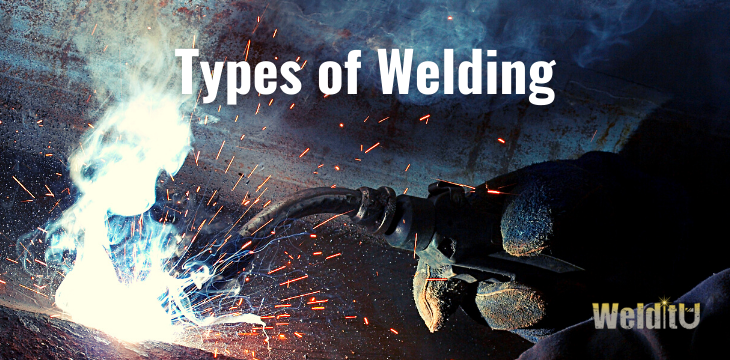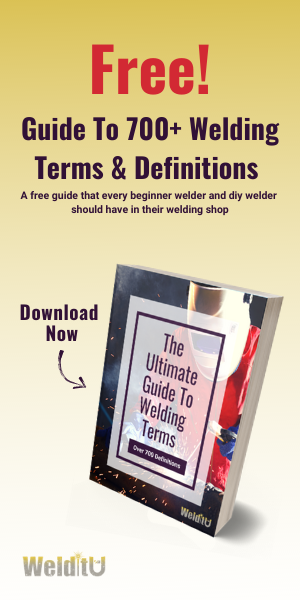The 4 Main Types of Welding and the Differences
There are four main types of welding:
- MIG Welding
- TIG Welding
- Stick Welding
- Flux Cored Welding
These are all forms of electric arc welding, which sets up a controlled arc between an electrode and the base metal. This arc provides the heat to weld metals together.

1. MIG Welding
MIG welding is a process developed in the late 1940s that radically changed the world of welding. It’s a method formally known as Gas Metal Arc Welding (GMAW).
In the field, it’s called metal inert gas or MIG welding, metal active gas or MAG welding, or simply wire welding. This method uses a continuously fed wire that performs two roles.
The wire first acts as an electrode to maintain the arc, then it melts and gets deposited into the weld. The extra metal fills in gaps to give you a stronger joint.
You’ll need an external tank to supply gas that will protect the arc and molten metal from contaminants. This shielding gas also provides other benefits.
Electric current, gas, and filler material travel, at a rate controlled by the welding machine, through a single cable to the welding gun. You get a one-handed, semiautomatic operation that is fast and simple to learn.
You are free to guide the torch and make adjustments as needed. What’s great is that with just a little practice, you can make good, strong welds on mild steel.
Combined with robotics, MIG is ideal for automated tasks in high-volume production work like auto manufacturing.
More advantages include:
- Works with most commercial metals and alloys, both ferrous and non-ferrous
- Works in all positions
- Produces neat, clean welds needing little clean-up
- Lightweight units can be carried to the work site
- Deposits a lot of metal to the weld
Some limitations of the MIG method are:
- Compared to manual processes, the equipment is more complicated, more costly and less portable
- Wind and drafts can remove gas from the arc
- Base metals must be very clean
- The large gun is more difficult to use in tight quarters
- High levels of heat and arc intensity are uncomfortable for some users
2. TIG Welding
Speed and ease of use define the MIG welding process. While TIG welding is a slower and more difficult technique to learn, it really shines when you need precise welds.
Invented for use on metals considered more difficult to weld, it’s officially known as Gas Tungsten Arc Welding (GTAW).
The more common acronym, TIG, is short for tungsten inert gas. The tungsten part refers to the electrode material which isn’t doesn’t burn off because of its extreme melting point.
This is a versatile and ultra-clean way of welding that you can use on more different metals than other methods of welding. It’s especially popular for aluminum and stainless steel projects.
Most TIG welding is manual work. You have a great deal of control, and the final result depends heavily on your skill and experience.
While guiding a torch supplied with current and gas, you’ll dab a rod of filler metal into the molten weld puddle. A foot, or torch control, lets you regulate heat levels.
Other benefits include:
- Strong, high-quality welds with almost any metal or alloy
- No slag, and usually no spatter, sparks, or smoke
- Effective on some metals without filler
Downsides to TIG welding:
- Slow speed is not good for large projects
- Easy to contaminate electrode
- Not effective with thick materials
- Must protect gas from drafts
3. Stick Welding
Stick welding or Shielded Metal Arc Welding (SMAW) is one of the most widely used forms of welding. It’s best for short welds in production, maintenance, repairs, and construction, especially with mild and low alloy metals over 18 gauge.
For common forms of welding, stick welding is one of the simplest and most versatile you’ll find. There’s no gas for you to deal with because the electrode rod or “stick” supplies both filler metal and flux for shielding. All you need at the business end is the electrode holder and work lead.
Stick is a manual style of welding that relies on you to start, maintain, and stop the arc. Starting an arc can be tricky, and maintaining it as the electrode gets used up takes some practice.
Overall, when compared to MIG, stick requires more skill. So you’ll need more practice and experience to get acceptable results.
Stick is slower than MIG or FCAW because you must stop to replace used filler rods as you weld. And after each pass, you’ll want to clean the metal to remove the coating of impurities called slag.
Additional advantages:
- Comparatively simple and inexpensive equipment
- Make welds in any position reached with an electrode (you can even bend them!)
- Relatively light and portable for field work
- Can extend leads to work longer distances from power source
- Quickly change electrode type for different materials (most ferrous and non-ferrous metals)
4. Flux Cored Welding
Flux Cored Arc Welding (FCAW) was developed as two variations, both based on a continuous wire feed.
The first is self-shielded, using flux inside the wire to prevent contamination from the inside-out. This is what most people mean when they talk about flux-cored.
Operation is like MIG without the gas. In fact, you can use flux-cored wire in a MIG machine. The lack of gas makes FCAW more portable, and dedicated equipment more affordable. This is a popular type of welding for beginners and occasional welders.
The flux core welding works better than MIG in drafty conditions and on dirtier materials. The quality is not as good, so it’s mostly used where strength and appearance aren’t critical.
The second version is gas-shielded where you use both a flux-cored electrode wire and an external shielding gas to improve quality and efficiency.
It’s usually a semiautomatic operation, so you control the gun while the machine feeds wire and controls the arc. Like stick welding, the flux core technique leaves behind a layer of slag that you’ll need to remove.
More benefits include:
- Fast speeds
- Good in all positions
- Continuous wire is more efficient than SMAW
- Deeper weld than SMAW
Here’s a super video showing the four main types of welding in action:

